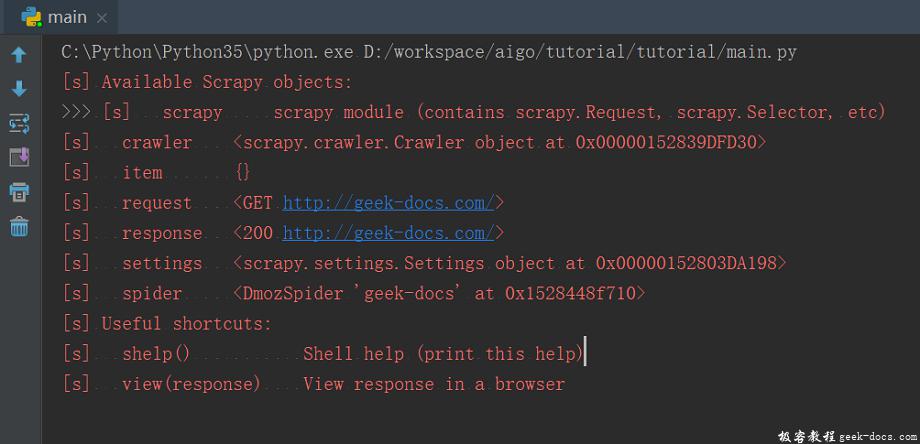Scrapy终端(shell)是一个交互终端,供您在未启动spider的情况下调试您的爬取代码。其本意是用来测试提取数据,你可以将其作为正常的Python终端,在上面测试任何的Python代码。
可以使用的方法:
shelp(): 打印可用的对象和方法fetch(url[, redirect=True]): 爬取新的 URL 并更新相关对象fetch(request): 通过 request 爬取,并更新相关对象view(response): 使用本地浏览器打开爬取的页面
启动终端
使用 shell 来启动Scrapy终端:
scrapy shell <url>
Scrapy Shell根据下载的页面会自动创建一些方便使用的对象,例如 Response 对象、Selector 对象。
- 当shell载入后,将得到一个包含response数据的本地 response 变量,输入
response.body将输出response的包体,输出response.headers可以看到response的包头。 - 输入
response.selector时, 将获取到一个response 初始化的类 Selector 的对象,此时可以通过使用response.selector.xpath()或response.selector.css()来对 response 进行查询。 - Scrapy也提供了一些快捷方式, 例如
response.xpath()或response.css()同样可以生效。
例如:
scrapy shell "http://hr.tencent.com/position.php?&start=0#a" --nolog
输出结果如图:

操作实列
Selector 的详细介绍可以参考文章选择器,如下所示,获取文章的标题和内容。
# 返回xpath选择器列表
>>> response.xpath('//title')
[<Selector xpath='//title' data='<title>搜索 | 腾讯招聘</title>'>]
# 使用extract方法返回 Unicode字符串列表
>>> response.xpath('//title').extract()
['<title>搜索 | 腾讯招聘</title>']
# 获取列表第一个元素
>>> response.xpath('//title').extract()[0]
'<title>搜索 | 腾讯招聘</title>'
# 返回 xpath选择器对象列表
>>> response.xpath('//title/text()')
[<Selector xpath='//title/text()' data='搜索 | 腾讯招聘'>]
# 返回列表第一个元素的Unicode字符串
>>> response.xpath('//title/text()')[0].extract()
'搜索 | 腾讯招聘'
>>> response.text
输出结果如图:

spider内调用shell
使用 scrapy.shell.inspect_response 函数 可以在spider内调用shell。
启动爬虫,将会在执行到inspect_response时进入 shell,当处使用完使用Ctrl-D退出 shell,爬虫会恢复运行。
import scrapy
class DmozSpider(scrapy.Spider):
name = "geek-docs"
allowed_domains = ["geek-docs.com"]
start_urls = [
"https://geek-docs.com/",
]
def parse(self, response):
from scrapy.shell import inspect_response
inspect_response(response, self)
输出结果如图:

 极客教程
极客教程